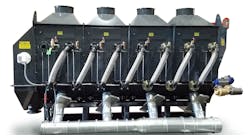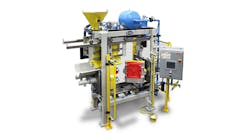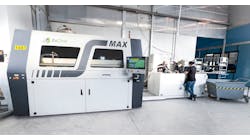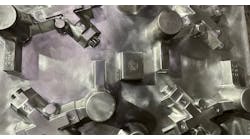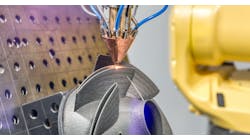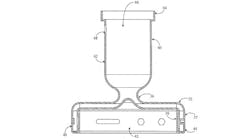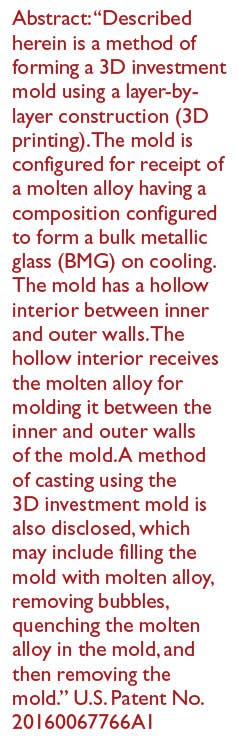For all the predictions of “disruption” claimed by promoters of 3D printing technologies, metalcasters (and the researchers and suppliers that support them) have done well by incorporating the principles and various methods of 3D printing into their production processes. Patterns, molds, and cores are formed successfully using additive manufacturing, and die and mold geometry can be repaired or restored, too.
But, of course, disruption is hard to anticipate, and some of the progress being made in design and engineering labs for products outside the scope of traditional metalcasting may be on a track to disrupt how everyone understands casting processes.
In March, Apple Inc. was granted a patent for a 3D printing process to be used to form investment-casting molds, which would be used to form parts from amorphous alloys. The two-layer mold would be used for a hollow casting process, solidifying molten metal in the cavity between the two layers.
What is notable, first, is that this production sequence may at once be a system for producing prototypes and/or finished parts. Because 3D printing would produce the molds, either prototypes or parts could be available quickly. The time and cost of producing a mold is condensed into the design of the finished part. Viewed from Apple’s perspective, it may be a shortcut to even faster product development or renewal sequences.
From a metalcasting perspective, this may be disruptive to standard investment casting, because it appears to the skip ceramic forming stage in mold production. Depending on the cost of the materials, among other factors, this may not reduce overall production costs but it may influence the scope and timing of product design and development.
Picture a manufacturer receiving the design of the part, then converting that design into an analogous mold, which is then produced using by 3D printing. Production of the prototype/part can begin once the mold is ready.
Even more disruptive to standard metalcasting may be the materials envisioned by Apple’s new patent – which relate in a significant way to previous patents claimed by the high-tech giant. In particular, one preceding patent Apple has been granted indicates that new devices will feature buttons formed in “metallic glass” (aka “liquid metal”) — amorphous alloys that offer better elasticity than titanium or stainless steel, so they revert to an original state more reliably. This, it is believed, would mean that a home button on a phone or tablet could be made pressure-sensitive, rather than the current design involing a dome switch that contacts a metallic element to initiate an electrical charge.
Amorphous metals (e.g., zirconium, titanium, and tungsten alloys) do not figure much into current metalcasting operations, and it’s only in the recent past that they have been available for processing – except by sintering powder metals.
In Apple’s latest patent, it describes how after a mold has been produced by 3D printing (layer by layer), it is ready to receive a molten alloy that will form a “bulk metallic glass” once it cools. The mold is shaped to form the housing of an electronic device. The patent describes the mold-filling method; the quenching process for the alloy within the mold; and the method for unmolding the finished casting.
As of now, being rather expensive, amorphous alloys are used to form specialized parts like medical devices, but also thin films and electronic components. In line with what may be assumed by the shape of the mold depicted in the patent, Apple lists potential applications for parts to be produced by its newly patented process. These include handsets for cellular or landline phones, smart phones, or other devices for sending and receiving electronic data. It may also be part of a digital display device (e.g., a browser screen or monitor for a computer or TV.) As such, the patent holder is outlining potentialities across the scope of telecom, data, and entertainment markets, for business and personal use — in short, all the areas in which it already has an outsized influence in product design and consumer preference.
Still unknown is the design function for any particular alloy in consideration for this molding process – or even how well the molding process works. By the time those details are known, the disruption may be nearly complete.




